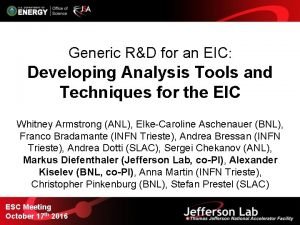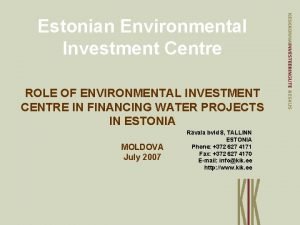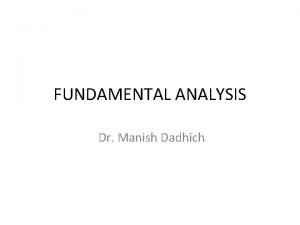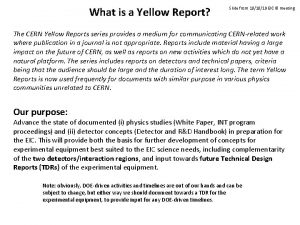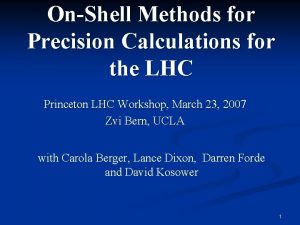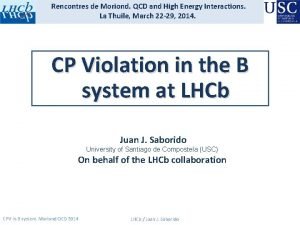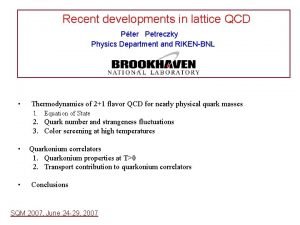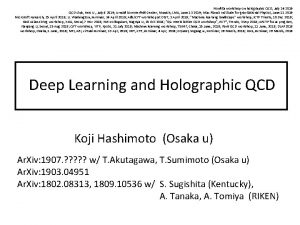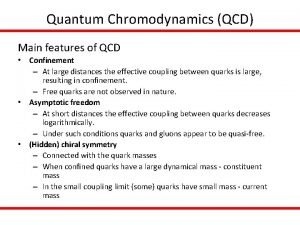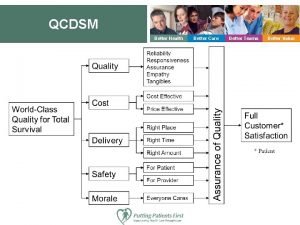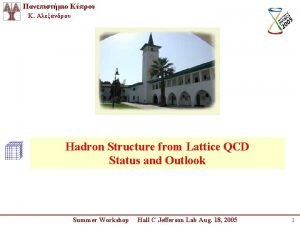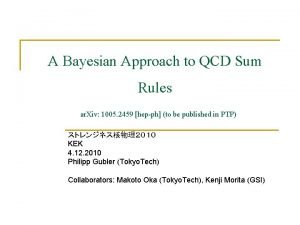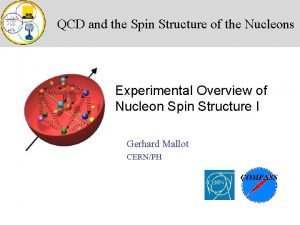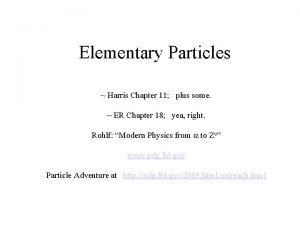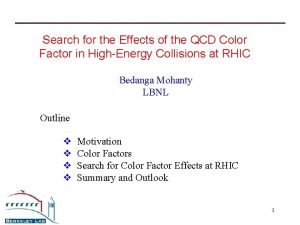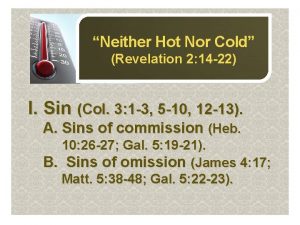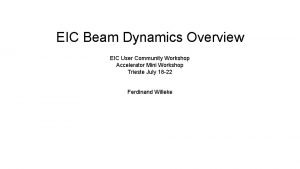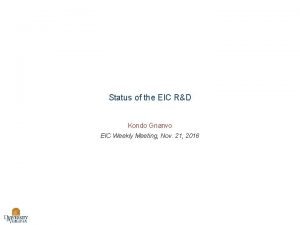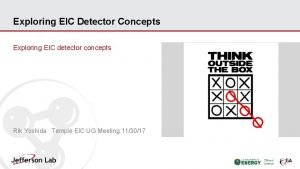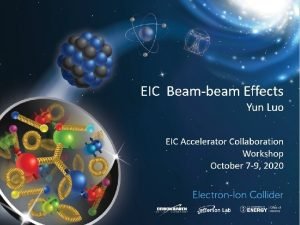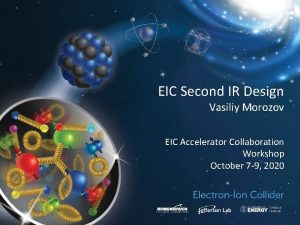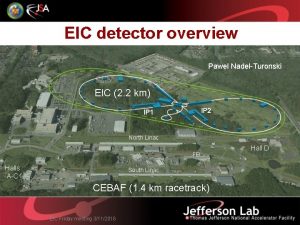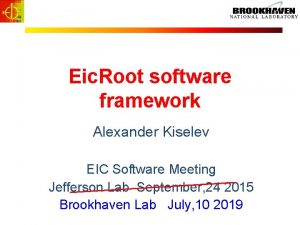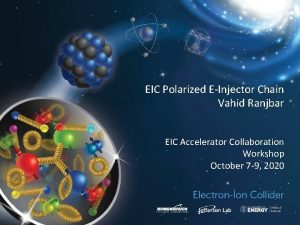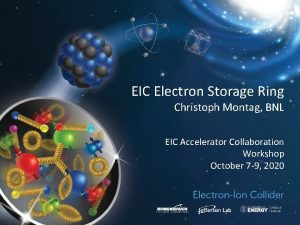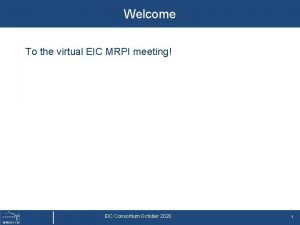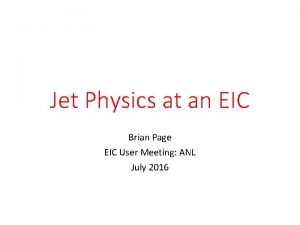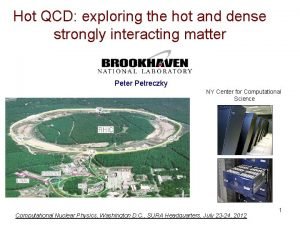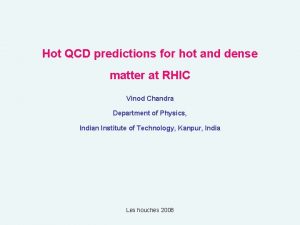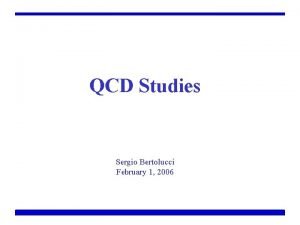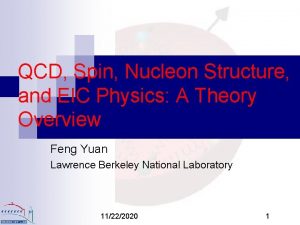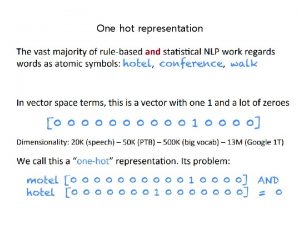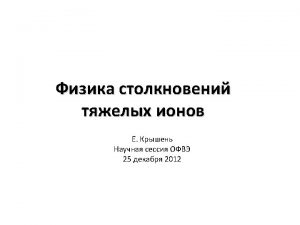EIC 2006 Hot QCD 19 th July 2006





























- Slides: 29

EIC 2006 & Hot QCD 19 th July 2006 Towards Three-Dimensional Imaging of the Proton Dieter Müller Arizona State University

Outline • Introductory remarks: • A short look back in history • How to resolve the proton? • Factorization: How to work with Quantum Chromodynamics? • Exploring the proton content • Form factors • Parton densities • An unifying concept: generalized parton distributions • Present and future experiments • Summary

What is the proton made of? The variety of hadrons is explained by an underlying symmetry “eightfold way”: M. Gell-Mann, G. Zweig, 1964 The proton is build from three quarks of masses ~ 300 Me. V and spin s = 1/2: Tremendously successful model in description of u u • Proton mass: • Proton spin: d • Hadron mass spectra • Magnetic moments, e. g. , • etc. • Proton spin solely built from the quark spins!

Quantum mechanical duality of particle and waves allows for a deeper look into matter: • Electron microscope E ~ 100 Ke. V resolution of • Particle accelerator: SLAC 20 Ge. V electron beam (1966) exploring the femto universe, i. e. , a resolution of

How to resolve the proton? • Experiments with highly energetic electromagnetic probe acting as a micro-scope electron virtual photon mass (=virtuality) g * (Q ) • Virtual photon resolves the proton on the distance: distance • The change with the resolution scale calculable within perturbation theory. is a QCD prediction,

How to study the proton High energetic scattering experiments on a proton target or beam with content? • lepton (electron, muon, or neutrino ) beam e. g. , DESY (27 Ge. V electron + 820 Ge. V proton beam) nizatio n JLab@6 Ge. V, hadro M, g elastic, exclusive deeply inelastic, inclusive inelastic, exclusive • hadron beam, e. g. , Tevatron@Fermilab (1 Te. V proton + antiproton beams), LHC etc.

Factorization • The scattering process of high energy particles appear at short distances. • However, in the asymptotic (initial and final) states hadrons are observed. • The basic concept for the application of QCD is factorization: • Precise measurements at the few percent level of (inclusive) observables

Form factor in quantum mechanics Elastic scattering of fast electrons on atoms. The cross section: Atomic form factor: charge density is the Fourier transform of the charge density. E. g. , the hydrogen atom in the ground state: with Bohr radius

Form factor in QCD The electric and magnetic charge distributions inside the proton are measured in elastic electron-proton scattering ep. Te’p’: electron virtual photon mass (= virtuality) quark • electric form factor • magnetic form factor Proton is not point-like! R. Hofstadter, 1955 (1961 Nobel Prize)

Interpretation of form factors momentum frame of proton at rest a fast moving proton Lorentz trans. x z y no spatial extent Form factors might be interpreted as transverse distribution of quarks irrespective of their longitudinal motion.

“Magnetic charge distribution” The QCD calculation of form factors remains challenging. • Form factors might be represented by wave functions: • • • Sensitivity to orbital momentum of quarks! • Confronting model calculations with data leads to new insights into the proton (orbital momentum, wave function shape)

R. P. Feynman, 1972 Parton densities (PDs) in QCD Deeply inelastic electron-proton scattering ep. Te’X : 2 PD y is the parton density, depending on longitudinal momentum fraction x=k||/p and transversal resolution scale d r^ ~ 1 Q No information on their transverse position! Proton has point-like constituents! D. Taylor, H. Kendall, J. Friedman, 1969 (1990 Nobel Prize) z x

“Spin crisis” The quark polarization inside the proton is measured within polarized scattering European Muon Collaboration (EMC) at CERN (1987): A polarized lepton scatters differently off quarks polarized along or opposite to the nucleon’s spin providing p The fraction of the proton spin carried by quarks is: (quark model prediction) EMC Coll. , 1987 “SPIN CRISIS”: … the result implies that a rather small fraction of the spin of the proton is carried by the spin of the quarks. Where is the rest? How to define it? How to measure it?

Building up the nucleon spin The spin of a composite particle is build from • spin of its constituents • orbital motion of constituents The angular momentum is given by the energy momentum density The sum rule for the proton spin X. Ji, 1996

Probing the proton with two photons D. Müller (Ph. D), 1992 et al. 1994 DVCS Bjo r lim ken it n Bjorken limit: time space ” ag db an “H GPD quantum mechanical incoherence of physical processes at short and large distances scales ensures factorization Non-invasive exploration of the proton!

Generalized parton distributions (GP D. Müller (Ph. D) 1992 et al. 1994 X. Ji; A. Radyushkin, 1996 y GPD z GPDs simultaneously carry information on both longitudinal and transverse distribution of partons in a proton GPDs contain also information on quark (orbital) angular momentum X. Ji, 1996 x

GPDs as a unifying concept GPDs are reducible to form factors and parton densities! PD FF GPD mass and gravitomagnetic charges (matrix element of energy-momentum tensor) orbital angular momentum femto holography (3 D picture of the proton) calculable in lattice QCD duality, etc.

“Holography” with photo leptoproduct leptoproduc ‘‘m irr or ’’ reference source Bethe-Heitler ‘‘splitter’’ lepton beam FF ‘‘m ’’ or irr detector GPD beam diffracted DVCSoff a parton NOTE: objects displayed in yellow are not present in real experiment!

Geometric picture of DVCS Initial state y Final state azimuthal asymmetry y x z x Cross section:

A. Belitsky, D. Müller, Extracting A. Kirchner, 2001 interference. Lepton-beam spin asymmetry Proton spin asymmetry Lepton-beam charge asymmetry Lepton-beam spin asymmetry Model A Model B HERMES CLAS

The quark distribution in the proton • The probability to find a quark in transversal direction from the proton center with momentum fraction x is no spatial extent • Theoretical constraints together with plausible assumptions give already a rough idea about the average squared distance in dependence of x and

The proton image at large W D. Müller 2006 • Photon leptoproduction measured at H 1 & ZEUS (DESY) allows to extract the deeply virtual Compton cross section 2 2 GPD DVCS + FF + Bethe-Heitler FF + interference subtracted

• A new representation for GPDs allows to make contact with Regge phenomenology [D. Müller, A. Schäfer (05)] (see also talk M. Kirch) GPD H • • • Sn Generalization of Mellin representation for DIS structure function Moments are labeled by complex angular momentum n These moments contain spin & orbital momentum coupling

• Near the `pomeron’ pole evolution is driven by gluons • Assuming gluonic `pomeron’ dominance at low input scale, we arrive to the Aligned Jet Model/dipole-quark picture for DVCS: Q GPD H 2 Ge. V evolution Q 0~ 0. 5 Ge. V GPD H Although, analyze can be performed in next-to-leading order [K. Kumerički, D. M. , K. Passek- Kumerički, A. Schäfer (2006)] we will rely in the following on the leading order approximation

• Small n x-behavior of H arises from pomeron poles: • x-independent pure gluonic input: -2 -1 non-leading singularities 1 `pomeron’ poles Pomeron dominance yields double log approx. , i. e. , DVCS data are described within three parameters: NG, BG , and Q 0 2

• fit yield NG=1. 97, BG=3. 68 Ge. V-2 and Q 0 =0. 7 Ge. V quark and gluon GPDs at low x in particular, parton distribution in impact parameter space 100 Ge. V 2 10 Ge. V 2 2 Ge. V 2 gluons mean squared value h~b 2 i quarks in transversal direction it on u b i tr n o glu NOTE: J/Y production yield a ~25% smaller value dis Strikman &Weiss (05)

A. Belitsky, D. Müller 2003 How one can measure GPDs? • Deeply virtual Compton scattering (clean probe) • Hard exclusive meson production (flavor filter) • etc. scanned area of the surface as a functions of lepton energy

Current and future facilities • Jefferson Lab @ 6 Ge. V: • • • Hall A: recoil detector* • Hall B: near beam calorimeter Jefferson Lab @ 12 Ge. V DESY • HERMES: recoil detector* • H 1 and ZEUS: polarized proton COMPASS @ CERN: recoil detector* EIC @ BNL? ELFE? * For full exclusivity of the scattering event!

Conclusions • The internal structure of the proton (hadrons) can be explored with generalized parton distributions from a new perspective: • 3 D partonic content of the proton • decomposition of the proton spin • Generalized parton distributions are a new theoretical concept: • unified description of form factors and parton densities • containing mass and gravitational form factors, etc. • messuarable in QCD lattice simulations • Experimentally accessible: (see parallel session Exclusive Physics) • hard exclusive electroproduction of photon or lepton pair • hard meson electroproduction, etc. • Generalized parton distributions allow also to explore nuclei in terms of partonic degrees of freedom
 Sensory language definition
Sensory language definition Eic software reviews
Eic software reviews Eic european investment centre
Eic european investment centre Eic approach of fundamental analysis
Eic approach of fundamental analysis Kickoff meting
Kickoff meting Fiu password reset
Fiu password reset Yellow report eic
Yellow report eic Qa eic patel the
Qa eic patel the Eic health certificate
Eic health certificate Qcd penrose
Qcd penrose Rencontres de moriond
Rencontres de moriond Qcd
Qcd Qcd
Qcd Confinement qcd
Confinement qcd Qcdsh
Qcdsh Qcd
Qcd Qcd sum rules
Qcd sum rules Qcd
Qcd Qcd lagrangian
Qcd lagrangian Electroweak interaction
Electroweak interaction Color factor qcd
Color factor qcd Perbedaan hot lava dan hot lava volcano
Perbedaan hot lava dan hot lava volcano Hot nor
Hot nor White hot vs red hot temperature
White hot vs red hot temperature Advantage of hot working
Advantage of hot working July 26 1953
July 26 1953 June 22 to july 22
June 22 to july 22 July 4 sermon
July 4 sermon Poppies in july poem
Poppies in july poem July 1-4 1863
July 1-4 1863

